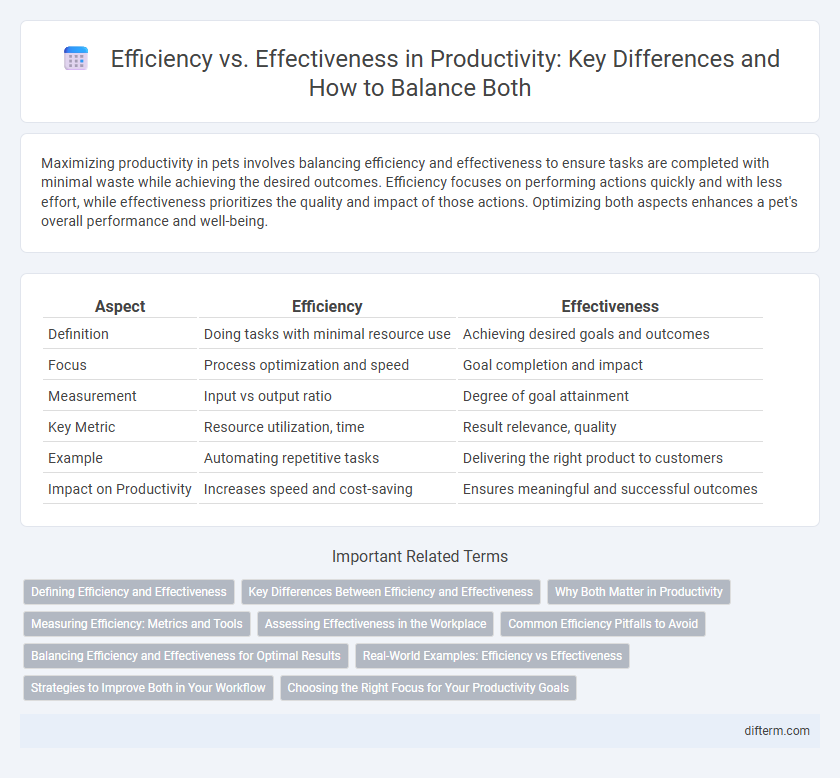Maximizing productivity in pets involves balancing efficiency and effectiveness to ensure tasks are completed with minimal waste while achieving the desired outcomes. Efficiency focuses on performing actions quickly and with less effort, while effectiveness prioritizes the quality and impact of those actions. Optimizing both aspects enhances a pet's overall performance and well-being.
Table of Comparison
| Aspect | Efficiency | Effectiveness |
|---|---|---|
| Definition | Doing tasks with minimal resource use | Achieving desired goals and outcomes |
| Focus | Process optimization and speed | Goal completion and impact |
| Measurement | Input vs output ratio | Degree of goal attainment |
| Key Metric | Resource utilization, time | Result relevance, quality |
| Example | Automating repetitive tasks | Delivering the right product to customers |
| Impact on Productivity | Increases speed and cost-saving | Ensures meaningful and successful outcomes |
Defining Efficiency and Effectiveness
Efficiency measures how well resources like time and energy are used to produce outputs, emphasizing minimal waste and maximum speed. Effectiveness gauges the extent to which goals and desired outcomes are achieved, focusing on the quality and impact of results. Both efficiency and effectiveness are essential metrics in productivity, with efficiency optimizing the process and effectiveness ensuring the right targets are met.
Key Differences Between Efficiency and Effectiveness
Efficiency measures how quickly and resourcefully tasks are completed, emphasizing minimal input for maximum output, while effectiveness assesses the degree to which goals or desired outcomes are achieved. The key difference lies in efficiency prioritizing process optimization and speed, whereas effectiveness centers on result quality and goal fulfillment. Balancing both efficiency and effectiveness is essential for maximizing overall productivity in any organization or project.
Why Both Matter in Productivity
Efficiency maximizes output by minimizing wasted resources, while effectiveness ensures the right goals are achieved, directly impacting productivity. Balancing both enables optimal task completion with sustainable progress and quality results. Ignoring either can lead to burnout or misaligned efforts, reducing overall work performance.
Measuring Efficiency: Metrics and Tools
Measuring efficiency in productivity involves tracking key performance indicators such as output per hour, resource utilization rate, and cycle time reduction. Tools like time-tracking software, workflow automation platforms, and productivity analytics dashboards provide real-time data to identify bottlenecks and optimize processes. Leveraging these metrics enables organizations to enhance operational efficiency while maintaining high-quality outcomes.
Assessing Effectiveness in the Workplace
Assessing effectiveness in the workplace involves measuring the degree to which goals and objectives are achieved, emphasizing outcome-oriented metrics over time spent. Efficiency focuses on minimizing resource use, such as time and cost, while effectiveness prioritizes the quality and impact of results, aligning with organizational priorities. Implementing key performance indicators (KPIs) and employee feedback mechanisms provides data-driven insights into effectiveness, guiding strategic adjustments for enhanced productivity.
Common Efficiency Pitfalls to Avoid
Common efficiency pitfalls include multitasking, which often reduces overall productivity by dividing attention, and neglecting task prioritization, leading to wasted effort on low-impact activities. Overreliance on tools without strategic planning can create bottlenecks rather than streamline workflows. Avoiding these traps enhances both efficiency and effectiveness in achieving key productivity goals.
Balancing Efficiency and Effectiveness for Optimal Results
Balancing efficiency and effectiveness is crucial for maximizing productivity, as efficiency emphasizes completing tasks quickly, while effectiveness ensures those tasks align with strategic goals. Optimal results arise from integrating time-saving techniques with goal-oriented actions, ensuring resources are not only used wisely but also directed toward impactful outcomes. This balance enhances overall performance by minimizing wasted effort and prioritizing meaningful achievements.
Real-World Examples: Efficiency vs Effectiveness
Efficiency measures how quickly tasks are completed with minimal resources, such as a factory reducing waste to produce more units per hour. Effectiveness evaluates the quality and impact of outcomes, like a marketing campaign that increases brand awareness and customer engagement. Companies like Toyota demonstrate efficiency through lean manufacturing, while Apple exemplifies effectiveness by creating innovative products that meet customer needs.
Strategies to Improve Both in Your Workflow
Balancing efficiency and effectiveness in your workflow requires implementing time management techniques such as the Pomodoro Technique and prioritizing tasks using the Eisenhower Matrix to maximize productivity. Streamlining processes with automation tools like Zapier or Trello enhances task execution speed while maintaining quality outcomes. Regularly reviewing performance metrics and adjusting strategies based on key performance indicators (KPIs) ensures continuous improvement in both efficiency and effectiveness.
Choosing the Right Focus for Your Productivity Goals
Efficiency measures how quickly tasks are completed, while effectiveness evaluates the impact of those tasks on your overall goals. Prioritizing effectiveness ensures that your productivity efforts align with meaningful outcomes rather than just speed. Selecting the right focus involves balancing task completion with goal relevance, optimizing both time management and quality results.
efficiency vs effectiveness Infographic

 difterm.com
difterm.com